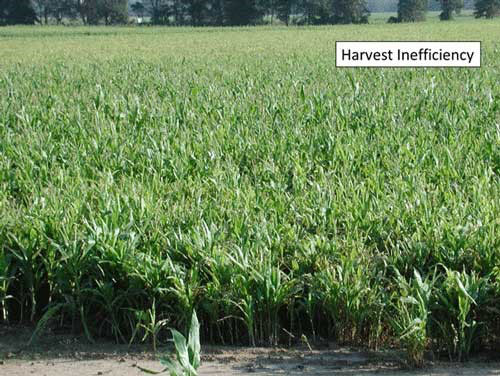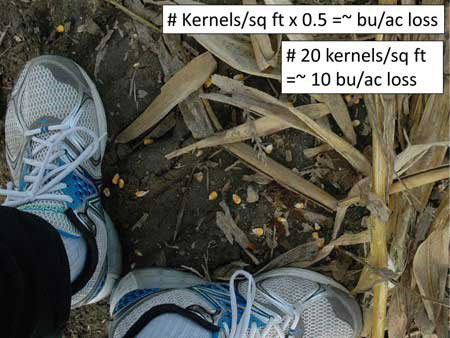This year has been a challenging year for crop production, especially corn, with above-average temperatures and below-average rainfall. Some fields will have a very limited yield, but regardless of the reduced yield, we need to be prepared to minimize yield losses that can occur during harvest operations.

Figure 1. Corn that was planted in early April has a good stand, with silking beginning in early/mid-June in southeast Kansas. Photo taken on June 23, 2022, by Bruno Pedreira, K-State Research and Extension.
Harvest inefficiency reduces overall yield and can cause future problems because of volunteer corn (Figure 2). Volunteer corn may have some value by increasing the soil organic matter, providing cover to reduce soil erosion, or providing potential forage for grazing livestock. However, volunteer corn may cause problems for wheat planting after corn harvest, or in a wheat-corn-fallow cropping system by using valuable soil moisture and nutrients needed to promote fall tillering in wheat. Volunteer corn can also provide a “green bridge” of vegetation for insects that can carry viral diseases in wheat.

Figure 2. Extremely thick stand of volunteer corn resulting from grain lost during harvest operations. Photo by Gretchen Sassenrath, K-State Research and Extension.
Several factors may contribute to poor harvest efficiency in corn. Most of the kernel loss that occurs at harvest time is due to mechanical limitations with combine settings. A combine performs three major actions during the harvest operation: picking, threshing, and cleaning. Grain loss can occur at each of these stages. A detailed description of harvesting efficiency can be found in the KSRE publication “Corn Production Handbook” beginning on page 36. The Handbook is available online at https://www.bookstore.ksre.ksu.edu/pubs/c560.pdf. A detailed article on reducing grain loss with proper combine settings will be in next week’s eUpdate.
Estimating yield loss
Yield loss estimates are made by counting the number of kernels per square foot and dividing by 2 (Figure 3). The number of kernels per square foot is approximately twice the bushels per acre lost. To estimate the yield loss, count the number of kernels in a square foot, and divide by 2 (or multiple by 0.5). For example, a count of 20 kernels per square foot would indicate 10 bu/acre lost during harvest.
While it may be time-consuming to count kernels over a large area, it is important to get a good estimate of yield loss by counting kernels and ears from several locations in the field, and also including both header and thresher losses. Changes can then be made in the harvest operation and to the combine to improve the harvest efficiency. It is also important to check for field losses at different times of the day when harvesting and on different fields. Changes in weather conditions (moisture and temperature) or other factors may impact harvest efficiency.

Figure 3. Estimate corn loss during harvesting by counting the number of kernels in a square-foot area. The number of kernels per square foot is approximately twice the number of bushels per acre lost. Count the number of kernels and divide by two – this is the bushel/acre yield loss. Several areas in a field should be checked. Photo by Gretchen Sassenrath, K-State Research and Extension.
While harvest efficiency will never be 100% and it is important to complete the harvest in a timely fashion, paying attention to details during harvest can increase profitability. A normal harvest loss rate to aim for is 1 to 2%. Careful attention to equipment, harvest conditions, and harvest operations can minimize yield losses at harvest time and put more corn in the bin.
There is a free mobile app from Ag PhD available to estimate harvest losses based on the kernel count per square foot. The download link is here: iOS. The app allows the user to select the crop and input the number of seed or kernels counted from an area on the ground. Harvest loss is calculated from this count.
Additional information is available in the KSRE publication “Corn Production Handbook” (https://www.bookstore.ksre.ksu.edu/pubs/c560.pdf).
Stay tuned to the eUpdate next week. We will discuss how to reduce grain loss by having the proper combine settings.
Bruno Pedreira, Area Agronomist, Southeast Research and Extension Center
pedreira@ksu.edu
Gretchen Sassenrath, Crops and Soils Agronomist, Southeast Research and Extension Center
gsassenrath@ksu.edu
Lucas Haag, Area Agronomist, Northwest Research and Extension
lhaag@ksu.edu